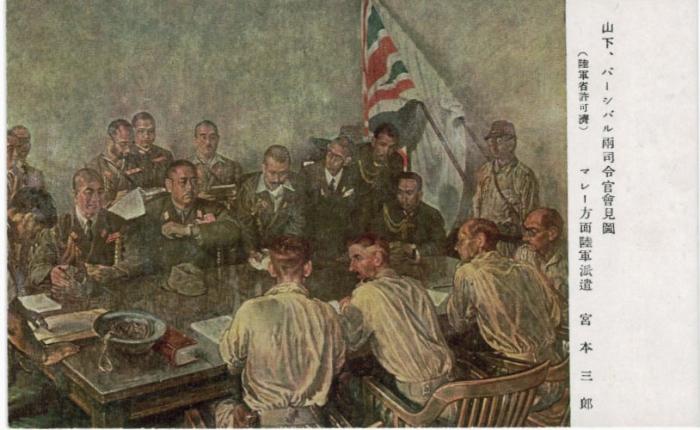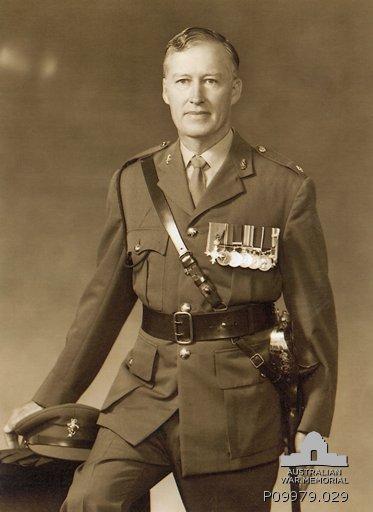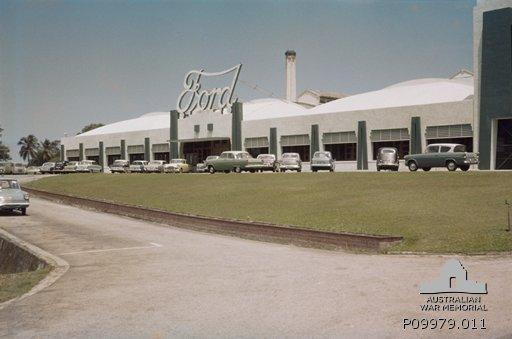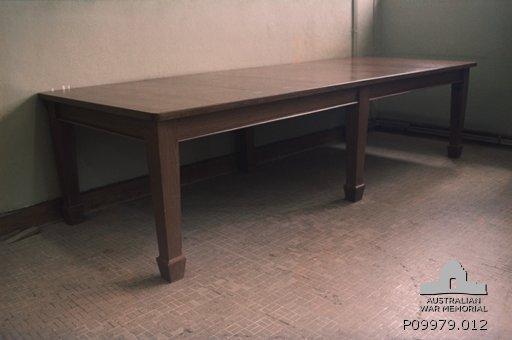Jack and the Singapore surrender table
The Singapore surrender table as display in the Second World War gallery of the Australian War Memorial.
This simple teak table is one of the most poignant physical reminders of one the darkest chapters of Australian and British military history, the fall of Singapore on 15 February 1942. Along with tens of thousands of Indian, Malaysian, Singaporean and British lives approximately 15,000 Australian servicemen and women’s fates were played out on this table.

"The meeting of General Yamashita and General Percival 1942" by Miyamoto Saburo
With this surrender came massive military, social and political changes to not just the Asia Pacific region but to around the world. The ramifications of this rapid assault and downfall of the British Empire are still felt around the region today. Both Malaysia and later Singapore were new nations were born post-war from events which unfolded on this table.
If it wasn’t for the interest, research and initiative of one man, Andrew John “Jack” Balsillie, this table may have not been saved for future generations.

In 1961 Jack was a serving Australian Army Warrant Officer with the Royal Australian Electrical and Mechanical Engineers (RAEME) on deployment to Malaya as part of the Australian Army’s commitment to the Malayan Emergency. His role was to assist with the repairing of Artillery guns and other technical equipment across various parts of Malaysia. To alleviate the long hours of travel he took a copies of the New South Wales Returned and Services League Journal called ‘Reveille’ for he and his men to read. On one journey to Singapore in February 1961 he was reading an article on the 2/30th Battalion’s ambush on Imperial Japanese troops at Gemencheh Bridge in Johor. He realised that he was actually on that very same Gemas-Tampin road through which hundreds of Japanese Army troops had cycled through 19 years before.
With his trusty copy of Reveille in hand, and with a picture of the bridge from the article he and his driver pulled over. Whilst inspecting the side of the road at the ambush location he found several Australian relics from the ambush including Australian manufactured .303 rounds, an old Army issued enamel plate and a grenade fuse cap. These discoveries sparked an interest that was to see him become a modern day Dr. Charles Bean, and collect from the battlefields of Malaya, Singapore and later South Vietnam some the most significant collection of objects from these campaigns in the National Collection.

In mid-1961 during a trip to Singapore and having learnt of the surrender of the British Commonwealth forces to the Japanese there, Jack visited the Ford Factory on Bukit Timah road. With him he had some wartime images of the surrender event he approached a member of the staff who had been there since the war. Inside the company boardroom they were able to identify the original teak table as the one which General Percival signed the surrender on 15 February 1942. The board room still had the original linoleum floor which still had hand written markings from the Japanese indicating where each respective representative was to sit (some of this lino was collected by Jack and it is held in the National Collection).

Jack enquired whether they would be happy to either sell or donate the table as a significant relic of the Australian contribution to the failed Malaya-Singapore campaign to the Australian War Memorial. He left his contact details, care of the Australian War Memorial, in the hope that they may donate the table.
Almost three years later, on 30 April 1964, Jack received communication from Ford Malaysia informing him that they had agreed to donate the historic piece of furniture, and the linoleum flooring, to the Memorial.
Ford’s public relations unit then contacted Jack who then referred them onto Jack Rutherford, the then ‘keeper of relics’ (curator) at the Memorial in Canberra to coordinate their offer of donation. Through this direct communication to the Memorial, Ford Malaya then shipped the original table to the Ford headquarters in Sydney, from where the table and section of flooring were safely transported to Canberra in October 1964.
With the exception of short period during a gallery redevelopment in 1998, this table has been on permanent display for almost 50 years in the Second World War gallery. This significant period of time clearly indicates the reverence and respect that this iconic relic has within the Australian War Memorial. The table is daily the focus of the popular Volunteer guided tour through the galleries and due to the popularity of the table it is the subject of well attended public presentations by Curators.
Since 1971 there has been two replica Singapore surrender tables built and they are both on display in Singapore at the superb “Memories of the Old Ford Factory” at Upper Bukit Timah Road (www.nas.gov.sg) and at the Surrender Chambers Museum/Fort Siloso http://www.fortsiloso.com/) at the popular tourist destination of Sentosa Island (formerly Blakang Mati, a former camp for Australian and Allied Prisoners of War). This latter replica table was built by the Australian War Memorial and gifted to Singapore in the mid 1970's.
A good colleague of mine, Dr Lachlan Grant features this table in his upcoming book "The Changi Book", details on the book can be found here : https://www.newsouthbooks.com.au/books/changi-book/. His recently published book "Australian Soldiers in Asia-Pacific in World War II" (https://www.newsouthbooks.com.au/books/australian-soldiers-asia-and-pacific-wwii/) is a 'must-read' on the Australian experience of the Malaya-Singapore campaign and later campaigns in the Asia-Pacific region. Another excellent reference specifically about the important work that Major Balsillie did in expanding the National Collection can be found in this most excellent research project completed in 2010 by AWM Summer Scholar Chelsea Mannix : Gathering the Malaya Collection: Jack Balsillie walking in the footsteps of C.E.W. Bean.
The Singapore Surrender table is one of the most historically significant relics held by the Australian War Memorial and it is my honour to help our veterans, families and visitors learn of and understand its deep significance and meaning to millions of people not just in Australia and the Asia Pacific but around the world.

This blog is dedicated to the memory of just one life that was decided on this table, Gunner Percy Suey of the 2/15th Field Regiment Royal Australian Artillery. He suffered greatly both physically and mentally as a result of severe beatings at the hands of his Imperial Japanese captors in Singapore. He went missing in 1976 and sadly no trace has been found of him still in 2015.

